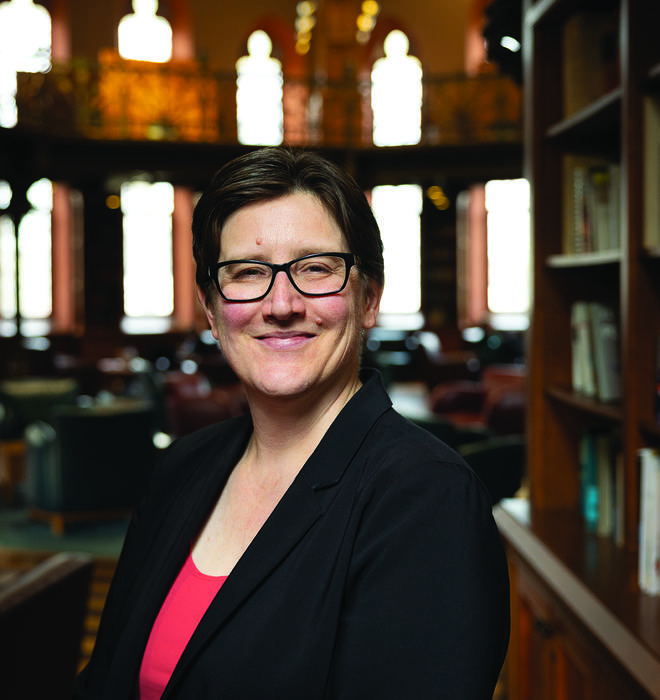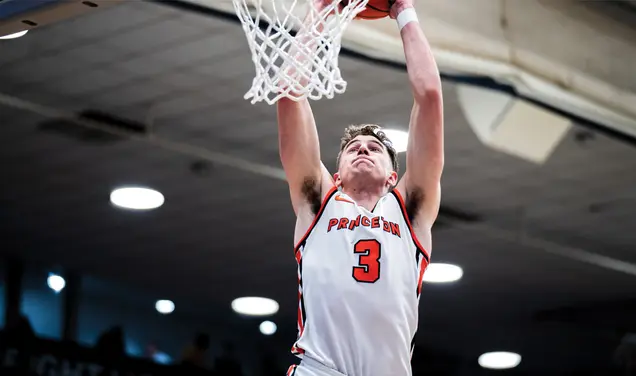
Q&A: New Provost Jennifer Rexford ’91
Rexford discusses diversity, student mental health, and why computer science is the most popular major
Jennifer Rexford ’91 becomes Princeton’s 14th provost on March 13, but she enters the job with a wealth of experience as a University administrator. The Gordon Y.S. Wu Professor in Engineering as well as a professor in the computer science department, Rexford has been the computer science department chair since 2015. During her tenure, computer science has become Princeton’s most popular undergraduate major and, conspicuous among computer science programs, which still tend to be male dominated, one in which nearly 40% of students majoring in the subject are women.
The provost is the University’s chief academic and budget officer, with additional responsibilities for long-range planning. Rexford succeeds Deborah Prentice, the Alexander Stewart 1886 Professor of Psychology and Public Affairs, who has been named vice-chancellor of the University of Cambridge.
A former winner of the Moses Taylor Pyne Honor Prize, the University’s highest undergraduate honor, Rexford earned a B.S.E. in electrical engineering at Princeton before earning her Ph.D. in electrical engineering and computer science at the University of Michigan. After working as an engineer at AT&T Research, she joined the faculty in 2005.
Taking a break from a campus-wide listening tour in January, Rexford sat down with PAW to discuss her new role in Nassau Hall.
What have you been hearing on your listening tour?
I recently visited the University Center for Human Values, partly because I didn’t know enough about it yet, but also because I’m looking for examples of interdisciplinary activities on campus and trying to learn what kind of practices allow academic communities to come together. I’ve also recently been to the architecture school, because they have a very different mode of teaching than the one I’m familiar with in computer science.
Have you gotten any advice from your predecessor, Deborah Prentice?
She and Treby Williams ’84 [the University’s executive vice president] have been walking me through different aspects of the job to bring me up to speed, particularly on the more internal parts that I wouldn’t have seen before. But I think the best advice I’ve gotten is to listen as much as I can during this period when I’m not actually in the role yet and have some time to learn about the parts of campus I don’t know as well. That, and find ways to bring people together who aren’t normally in conversation with one another but may have something to contribute to a particular initiative.
Will you be able to continue teaching?
I think so, but probably not in the first year or two, because I want to devote all my time and energy to my new role. I really enjoy teaching, though, and often teach one of our sophomore-level computer science courses. I’m going to miss that.
What are your immediate priorities as provost?
I’m still learning, so I don’t know that I have a definitive answer.
I have noticed a few recurring themes from my time as department chair. One is that a lot of the most exciting activities on campus cross disciplinary boundaries. I’d like to figure out the best way to help facilitate that, whether that’s in the form of resources, or bringing people together, or just learning best practices from the successful activities already on campus.
A second priority is thinking more about our impact on the world. How can we help the research and teaching we do at Princeton have a broader impact in society and especially in higher education? A lot of faculty across divisions of the University have an appetite for external research, and we can do a lot to support them in having their research and educational innovations reach a larger audience, so they don’t get bogged down in things like tech transfer and administrative problems. Faculty in the science and engineering departments would love to see their ideas and innovations used in practice. It might be that research software engineers or the right kind of computing platform could help make that happen.
What do you mean by tech transfers?
Let’s say a faculty member is doing research on biomedical data science, trying to turn medical data into insights that would provide better health outcomes. They might be creating software that could accomplish that, and they might be using that software to do experiments for a research paper. If that software were made widely available, it might help medical practitioners or researchers at other schools. So, the question is, what could the provost’s office do to help that faculty member make their software or datasets usable by other people?
Computer science has become the University’s most popular major during your time as department chair. What accounts for that surge in popularity?
Part of it is a national trend. Computer science is growing everywhere. I think that, in large part, that’s because a lot of students see it as a lever towards affecting change in the world.
At Princeton, we have created a culture where we take all comers to computer science. We don’t try to weed anyone out. And we’ve tried to make our introductory curriculum accessible to nonmajors and students who might not have had the opportunity to program in high school. Today, almost half of the students in our intro course, COS 126, have never coded before — and more than half of the students at Princeton take that course! We really want it to be something that could be part of any student’s experience.
Computer science has also achieved something close to gender parity. Are there lessons there for other departments?
I think the key has been making our introductory course accessible to students who haven’t been exposed to computer science before. We even have preceptorial sections that are designed for students who haven’t coded before, so they’re not in their first semester at Princeton and finding themselves in precept with someone who interned at Google for three summers and might be showing off a little bit.
Another key has been letting students do independent work or write a thesis on a topic they’re excited about. We offer a B.S.E. degree, but we also have a lot of students in our A.B. program and a lot of our gender diversity started to increase when the number of A.B. majors went up. These were students who might not have anticipated that they would want to study computer science when they came here. Or they might have seen computer science as something to combine with a second passion that they have.
The department has gone from having fewer than 20% women majors to close to 40% now, and that’s with the enrollment growing. We now have 220 members of the current junior class majoring in computer science. I’m proud of that. When I was an undergraduate electrical engineering major at Princeton, there was one woman computer science major a year. And now it’s either the first or second most popular major for women at Princeton.
I think there’s a mental health challenge across higher education, and Princeton unfortunately is not immune to it. I think it’s a national or even a global trend. But obviously, whether it is or isn’t part of a wider trend, we need to do something to help our students. It’s heart-rending.
In an interview with The Daily Princetonian recently, President Eisgruber said that “high aspiration environments” such as Princeton “are consistent with mental health.” Do you share his view?
Obviously, there is more to do here. We’re coming out of an incredibly difficult period for students with the COVID situation. That’s certainly one issue. I think the role of technology in students’ lives also can be isolating in its own way. There’s a lot more we could do to better understand how to help students have a healthy relationship with technology.
Three Princeton students have died by suicide within the last year. Is there a mental health crisis on campus? [Two other students died, one following a prolonged illness, after the interview was conducted. See “On The Campus,” page 13.]
I think there’s a mental health challenge across higher education, and Princeton unfortunately is not immune to it. I think it’s a national or even a global trend. But obviously, whether it is or isn’t part of a wider trend, we need to do something to help our students. It’s heart-rending.
From a mental health standpoint, do you think the atmosphere on campus has changed since you were an undergraduate?
I’m certainly no expert, but I do feel that, when I was a student, we didn’t talk about mental health. And I think it’s good that students are more vocal about mental health issues now than they used to be and more supportive of one another.
The University recently released its second annual diversity, equity, and inclusion report. Can you talk about what accomplishments have been made and where work still needs to be done?
One thing that’s exciting, and which has been happening all over campus including in my own department, is making efforts to sponsor DEI activities at the department and center level, and in doing so to meet students or prospective students — or even the larger community — where they are. Just as an example, in the fall of 2020, the computer science department had an independent work seminar on data science for Black Lives Matter called “Machine Learning for Social Justice: Data Analysis to Study the Black Lives Matter Movement.” The students were really excited to find ways in which they could bring computing to bear on social justice issues that they cared about. They were doing a wide range of computational studies on different datasets to better understand the state of racial inequities in the country and what types of interventions might be helpful. I think we can find interesting ways for the students’ academic pursuits to intersect with their desire to be part of the change that they want to see in the world.
There is concern that the Supreme Court could strike down or sharply restrict affirmative action this year. Is the University thinking about how it might respond to that?
I don’t have a lot to say on that yet, but certainly Princeton and our peer institutions are talking a lot about this, because we all share a common conviction that a diverse student body provides a richer experience for everyone.
The University seems to get bigger every year. How does the University keep the special closeness that Princeton is famous for in a place that is so much larger than it was 50 years ago?
Something that’s really special about Princeton is that you can walk from one end of the campus to the other and run into people and know who they are. I don’t think there is any one solution for how to maintain that.
As the campus has grown, we have tried to develop neighborhoods around different academic disciplines, so there’s a closeness among related fields such as engineering or the humanities. I think another thing that helps is creating opportunities for people to bump into each other in the day-to-day life of the campus, whether it’s at interdisciplinary centers or physical spaces like cafés and places to take meals together. I think you need to have both serendipity and proximity to help people make those connections.
Long-range planning is one of the provost’s responsibilities. Have you given any thought to what Princeton will look like 10 or 20 years from now? What kind of place is it going to be?
Well, I hope that we will have expanded our reach, both in terms of the number and diversity of students on campus, and that we will have found even more effective ways to reach the community off campus, whether that’s with educational initiatives or with the research that we do.
Mark F. Bernstein ’83 is PAW’s senior writer.






No responses yet